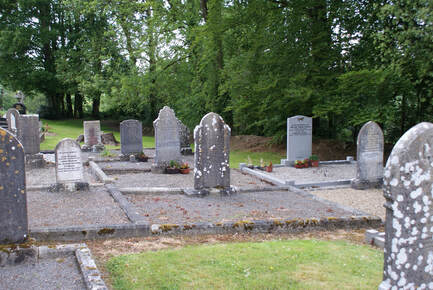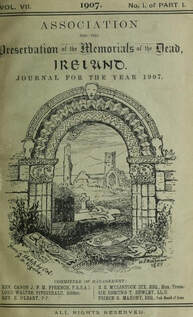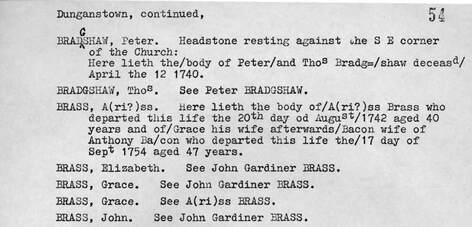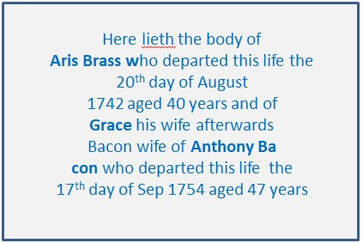"Midnight Feasts" - Hunting for Irish Monumental Inscriptions
 St. John's graveyard, Clonmore - (c) Wiggy
St. John's graveyard, Clonmore - (c) Wiggy
Gravestones are expensive monuments, so always think about the financial circumstances of your ancestor's family. For example, a pauper or common grave may have been their final resting place - especially true if they perished in the workhouses in the dreadful years of the 1840's. Infants and children may not even be named but hinted at with phrases like "and 3 of their children." They may not even have their own grave but may have been placed in the coffin of an adult burial taking place at the same time for expediency.
Where they could afford it, extended families were often buried in the same churchyards and cemeteries in either shared graves or adjoining plots. So, where you can, either in person or via any online sources, always note everyone who shares the grave with your ancestor or is buried nearby, even if the names are currently unfamiliar to you. In time, I'm sure you will find connections.
Where they do exist, gravestones often reveal much about families and once you find a death record, try to seek out a burial record and from that any transcripts of monumental inscriptions in the cemetery. But where can you find these records?
Many wonderful volunteers have roamed the Irish countryside transcribing headstones and you will find quite a lot of their efforts published in the various county pages of the Ireland Genealogical Projects (IGP). Some of these pages also have helpful standard sub-headings, one of which is "Cemeteries". Not only might you find transcripts, but there might also be photographs of the headstones too.
Where they could afford it, extended families were often buried in the same churchyards and cemeteries in either shared graves or adjoining plots. So, where you can, either in person or via any online sources, always note everyone who shares the grave with your ancestor or is buried nearby, even if the names are currently unfamiliar to you. In time, I'm sure you will find connections.
Where they do exist, gravestones often reveal much about families and once you find a death record, try to seek out a burial record and from that any transcripts of monumental inscriptions in the cemetery. But where can you find these records?
Many wonderful volunteers have roamed the Irish countryside transcribing headstones and you will find quite a lot of their efforts published in the various county pages of the Ireland Genealogical Projects (IGP). Some of these pages also have helpful standard sub-headings, one of which is "Cemeteries". Not only might you find transcripts, but there might also be photographs of the headstones too.
 Journal Frontispiece (see links below)
Journal Frontispiece (see links below)
Another great free resource is the rather grandly titled "Journals of the Association for the Preservation of the Memorials of the Dead in Ireland" (JAPMDI).
This was an organisation founded in the 1880's, its membership consisting of various amateur historians who could see how quickly time and the Irish weather were eroding gravestones. They valiantly transcribed what they could and submitted articles for their journal, published in year ranges, sometimes in parts. They invariably did not transcribe whole graveyards, perhaps only picking out their favourites or the oldest headstones, but some did attempt complete transcriptions, which was very lucky for me in the case of St. Fiaac's, Clonegal. The most important thing to appreciate with this resource is that the gravestones from which they managed to capture precious weathered inscriptions may no longer be legible or even exist in situ, so this may be your only chance to learn what became of some of your ancestors.
The journals were published between 1888 and 1934 and you may find copies in national and local reference libraries in Ireland - check out their catalogues if you are visiting any. However, most of the early ones have been digitised and published online for free in various places. I found many of them on Archive.org and the links below should take you straight to the relevant years. Remember these are publication years - the inscriptions transcribed therein could come from any time prior to this.
There are usually index pages in the front of the journals, sometimes arranged by county or just alphabetically by place, but nothing beats browsing to appreciate the scope and detail of what was collated. This is definitely a case of getting lucky with this resource - for example it was in one of these articles I found my Jones patriarch who died aged 99 in 1830, which made him unusual enough for a contributor to pick out his gravestone as worthy of a mention in the journal.
If you want to learn much more about the journals and access an excellent finding aid, then visit Mems Dead, which is where I also gratefully found a link for the index to the first 7 volumes published in 1914 entitled "Journal of the Association for the Preservation of the Memorials of the Dead in Ireland: Consolidated Index of Surnames and Placenames to Volumes I to VII (1888-1909) by Miss Vigors and Mrs Pierce G. Mahony. This can be browsed on FamilySearch, where there is also a browsable Index of the Churchyards and Buildings too. However, I do recommend settling down for a good read of the journals as there is lots to divert you in these pages.
This was an organisation founded in the 1880's, its membership consisting of various amateur historians who could see how quickly time and the Irish weather were eroding gravestones. They valiantly transcribed what they could and submitted articles for their journal, published in year ranges, sometimes in parts. They invariably did not transcribe whole graveyards, perhaps only picking out their favourites or the oldest headstones, but some did attempt complete transcriptions, which was very lucky for me in the case of St. Fiaac's, Clonegal. The most important thing to appreciate with this resource is that the gravestones from which they managed to capture precious weathered inscriptions may no longer be legible or even exist in situ, so this may be your only chance to learn what became of some of your ancestors.
The journals were published between 1888 and 1934 and you may find copies in national and local reference libraries in Ireland - check out their catalogues if you are visiting any. However, most of the early ones have been digitised and published online for free in various places. I found many of them on Archive.org and the links below should take you straight to the relevant years. Remember these are publication years - the inscriptions transcribed therein could come from any time prior to this.
There are usually index pages in the front of the journals, sometimes arranged by county or just alphabetically by place, but nothing beats browsing to appreciate the scope and detail of what was collated. This is definitely a case of getting lucky with this resource - for example it was in one of these articles I found my Jones patriarch who died aged 99 in 1830, which made him unusual enough for a contributor to pick out his gravestone as worthy of a mention in the journal.
If you want to learn much more about the journals and access an excellent finding aid, then visit Mems Dead, which is where I also gratefully found a link for the index to the first 7 volumes published in 1914 entitled "Journal of the Association for the Preservation of the Memorials of the Dead in Ireland: Consolidated Index of Surnames and Placenames to Volumes I to VII (1888-1909) by Miss Vigors and Mrs Pierce G. Mahony. This can be browsed on FamilySearch, where there is also a browsable Index of the Churchyards and Buildings too. However, I do recommend settling down for a good read of the journals as there is lots to divert you in these pages.
 Image from Cantwell's entries for St. Kevin's, Dunganstown, Co. Wicklow
Image from Cantwell's entries for St. Kevin's, Dunganstown, Co. Wicklow
Brian Cantwell's, "Cantwell's Memorials of the Dead" was rather a lifetime's work and you will bless his dedication to the cause if you have kin interred in Cos. Wicklow and Wexford in particular. He also covered some graveyards in other counties such as the south of Co. Dublin and the west of Co. Clare.
The records can be bought on CD and searched on the subscription website, FindMyPast. There are also images of the original typed notes like the image here. These were working notes so look out for hand-written amendments and remember that there are very likely to be discrepancies between these transcripts and burial registers due to erosion of the headstones, especially with respect to numbers.
There was a website run by his son, Ian Cantwell that had some very useful extra indexes of names and places but the previous link I had no longer works. There is access via the Internet Archive to the last version from 2018 so try there. In particular, this is where you will find details of the numbers used (top right on the image) for each graveyard. Handy for realising FindMyPast had put up the wrong images for one graveyard I was interested in... Surnames and placenames are also cross-referenced to these same numbered graveyards.
The records can be bought on CD and searched on the subscription website, FindMyPast. There are also images of the original typed notes like the image here. These were working notes so look out for hand-written amendments and remember that there are very likely to be discrepancies between these transcripts and burial registers due to erosion of the headstones, especially with respect to numbers.
There was a website run by his son, Ian Cantwell that had some very useful extra indexes of names and places but the previous link I had no longer works. There is access via the Internet Archive to the last version from 2018 so try there. In particular, this is where you will find details of the numbers used (top right on the image) for each graveyard. Handy for realising FindMyPast had put up the wrong images for one graveyard I was interested in... Surnames and placenames are also cross-referenced to these same numbered graveyards.

By the way, the transcriptions have been done in a very particular style whereby the design of the script as it was carved into the headstone was preserved, by using "/" symbols to show where a new line begins below the previous one. Try making a drawing yourself like this one to see what shape the text might have made on the gravestone and perhaps that might help you to locate the headstone in the graveyard if you visit. Cantwell created these transcripts in the last 20 years of his life before his death in 1992, so there is a good chance that many of the details he noted down have weathered further and may now be indecipherable. That was certainly the case when I visited St. Kevin's in Dunganstown to view these graves, although it depends on the material used. Flat slate ground slabs from the 18th century had actually fared better than later upright stones. Lichen is also your friend when the script has weathered as it often colonises the depressions and flowers in different contrasting colours to the stone. Shadows help too so try different camera angles at different times of the day.
Which reminds me, be sure to make use of as many sources as possible for the same graveyard as you will be surprised what some people saw and some people didn't - see my blog piece on Henry Revell buried in this same graveyard for a good example of what I mean.
Which reminds me, be sure to make use of as many sources as possible for the same graveyard as you will be surprised what some people saw and some people didn't - see my blog piece on Henry Revell buried in this same graveyard for a good example of what I mean.
The From-Ireland website claims to have about 70,000 gravestone inscriptions that can be searched for free. However, personally speaking, I find the blizzard of adverts intrusively tiresome after a while. I think the same records are available to search on FindMyPast if you prefer in the collection entitled Ireland Gravestone Records, although the record volumes are lower? There is also a large collection of gravestone photographs available exclusively on From-Ireland - take a look and you might get lucky with a graveyard you are interested in. Not all the photographs are legible but if you think there is one that looks promising, get in touch with the site owner and you can purchase a larger copy.

Another growing free source of cemetery transcriptions worldwide is Find A Grave which claims to have over 3000 Irish burial locations, some with just a few entries, others with more significant listings and many with attached photographs for you to verify the information for yourself.
However, be aware that the site tackles Irish geography from a modern perspective, so if you want to search by county, their Cemeteries in Ireland page will only bring up a list of the 26 counties in the Republic. If you are interested in the 6 counties of Northern Ireland, you will have to browse Cemeteries in Northern Ireland.
The other thing to take care with is that all content is supplied by volunteers - anyone can add anything to it. This is great when people add photos of the headstones and/or burial registers but how should you interpret information with no supporting photos? Contributors are also increasingly appending extended family histories to some memorials, which is fine when you can see that there is a family plot and they are all buried side by side. Some entries for family members may link directly to other cemeteries featured on Find A Grave - again, great if there are photos to support the names. However, I have to say that I am increasingly finding these long augmented entries with no supporting photo evidence or, of course, any source citations. So whilst it is great to share in the largesse of such a huge volunteer genealogical community, as ever, take care with what you find and try to corroborate the entries with evidence from elsewhere if you can. If you want to give something back to the community, then consider taking some extra photographs the next time you visit a cemetery yourself and post them on the site for the benefit of others.
The site design is fairly "noisy" with adverts I'm afraid and the graphics and logo are right out of Disney, but it's free. If you do locate ancestors through it, there might be a chance that you are related to the contributor if they have made a very personal addition to the website, although some lovely altruistic people do make it their mission to take huge numbers of photographs rather than just their own graves of interest. Click on the contributor's name and you can see the scale of their contributions and, crucially, whether they want to be contacted or not.
However, be aware that the site tackles Irish geography from a modern perspective, so if you want to search by county, their Cemeteries in Ireland page will only bring up a list of the 26 counties in the Republic. If you are interested in the 6 counties of Northern Ireland, you will have to browse Cemeteries in Northern Ireland.
The other thing to take care with is that all content is supplied by volunteers - anyone can add anything to it. This is great when people add photos of the headstones and/or burial registers but how should you interpret information with no supporting photos? Contributors are also increasingly appending extended family histories to some memorials, which is fine when you can see that there is a family plot and they are all buried side by side. Some entries for family members may link directly to other cemeteries featured on Find A Grave - again, great if there are photos to support the names. However, I have to say that I am increasingly finding these long augmented entries with no supporting photo evidence or, of course, any source citations. So whilst it is great to share in the largesse of such a huge volunteer genealogical community, as ever, take care with what you find and try to corroborate the entries with evidence from elsewhere if you can. If you want to give something back to the community, then consider taking some extra photographs the next time you visit a cemetery yourself and post them on the site for the benefit of others.
The site design is fairly "noisy" with adverts I'm afraid and the graphics and logo are right out of Disney, but it's free. If you do locate ancestors through it, there might be a chance that you are related to the contributor if they have made a very personal addition to the website, although some lovely altruistic people do make it their mission to take huge numbers of photographs rather than just their own graves of interest. Click on the contributor's name and you can see the scale of their contributions and, crucially, whether they want to be contacted or not.
Overseas Burials
If you are not having any success finding your Irish-born relative buried in Ireland, then there is of course the distinct possibility that their final resting place lies overseas. In fact, this might be the first inkling that you get that they emigrated!
Find A Grave, detailed above, is a worldwide resource so narrow your search by country and any other available geographical filters on their Cemetery Search screen. Billion Graves is another volunteer fuelled site that might yield international treasure in the form a photographed headstones. These 2 sites are probably your best bet to start off with for the USA and Canada perhaps when you have no idea where your relatives might have ended up.
Finding collections of monumental inscriptions online is a bit hit and miss on the big commercial sites. I've had a go at searching their card catalogues with a combination of keywords (think "inscription", "gravestone", "headstone") and can see there are lots of small collections categorised thus. Try yourself and filter by location accordingly. Therefore, what appears under the following country headings are just some fairly large collections that I think might be a good place to start.
As to original sources, this sort of genealogical information is often the work of diligent members of local family history societies (FHS), out in all weathers trying to record what they see before it fades from view.
Scotland
Scottish Monumental Inscriptions (FMP=£) c.1m records mostly from NE Scotland FHS - check source list. Many images attached but not all records.
England & Wales
FINDMYPAST English Monumental Inscriptions Collections (FMP=£) Organised by county, but not for all counties.
FINDMYPAST Welsh Monumental Inscriptions Collections (FMP=£) Only for Montgomeryshire & Glamorgan.
USA
United States Billion Graves Index (FMP=£) c.22m records that link through to the third party site.
Canada
FamilySearch Canadian BMD Collections Some cemetery collections in here, including a link to the third party collection below.
Canadian Gravestones Free site which includes photographs.
Australia & New Zealand
New Zealand, Cemetery Transcriptions, 1840-1981 (FamilySearch) c.487k records. Transcripts & images of transcripts.
If you are not having any success finding your Irish-born relative buried in Ireland, then there is of course the distinct possibility that their final resting place lies overseas. In fact, this might be the first inkling that you get that they emigrated!
Find A Grave, detailed above, is a worldwide resource so narrow your search by country and any other available geographical filters on their Cemetery Search screen. Billion Graves is another volunteer fuelled site that might yield international treasure in the form a photographed headstones. These 2 sites are probably your best bet to start off with for the USA and Canada perhaps when you have no idea where your relatives might have ended up.
Finding collections of monumental inscriptions online is a bit hit and miss on the big commercial sites. I've had a go at searching their card catalogues with a combination of keywords (think "inscription", "gravestone", "headstone") and can see there are lots of small collections categorised thus. Try yourself and filter by location accordingly. Therefore, what appears under the following country headings are just some fairly large collections that I think might be a good place to start.
As to original sources, this sort of genealogical information is often the work of diligent members of local family history societies (FHS), out in all weathers trying to record what they see before it fades from view.
Scotland
Scottish Monumental Inscriptions (FMP=£) c.1m records mostly from NE Scotland FHS - check source list. Many images attached but not all records.
England & Wales
FINDMYPAST English Monumental Inscriptions Collections (FMP=£) Organised by county, but not for all counties.
FINDMYPAST Welsh Monumental Inscriptions Collections (FMP=£) Only for Montgomeryshire & Glamorgan.
USA
United States Billion Graves Index (FMP=£) c.22m records that link through to the third party site.
Canada
FamilySearch Canadian BMD Collections Some cemetery collections in here, including a link to the third party collection below.
Canadian Gravestones Free site which includes photographs.
Australia & New Zealand
New Zealand, Cemetery Transcriptions, 1840-1981 (FamilySearch) c.487k records. Transcripts & images of transcripts.
(c) Irish Geneaography - 2022
